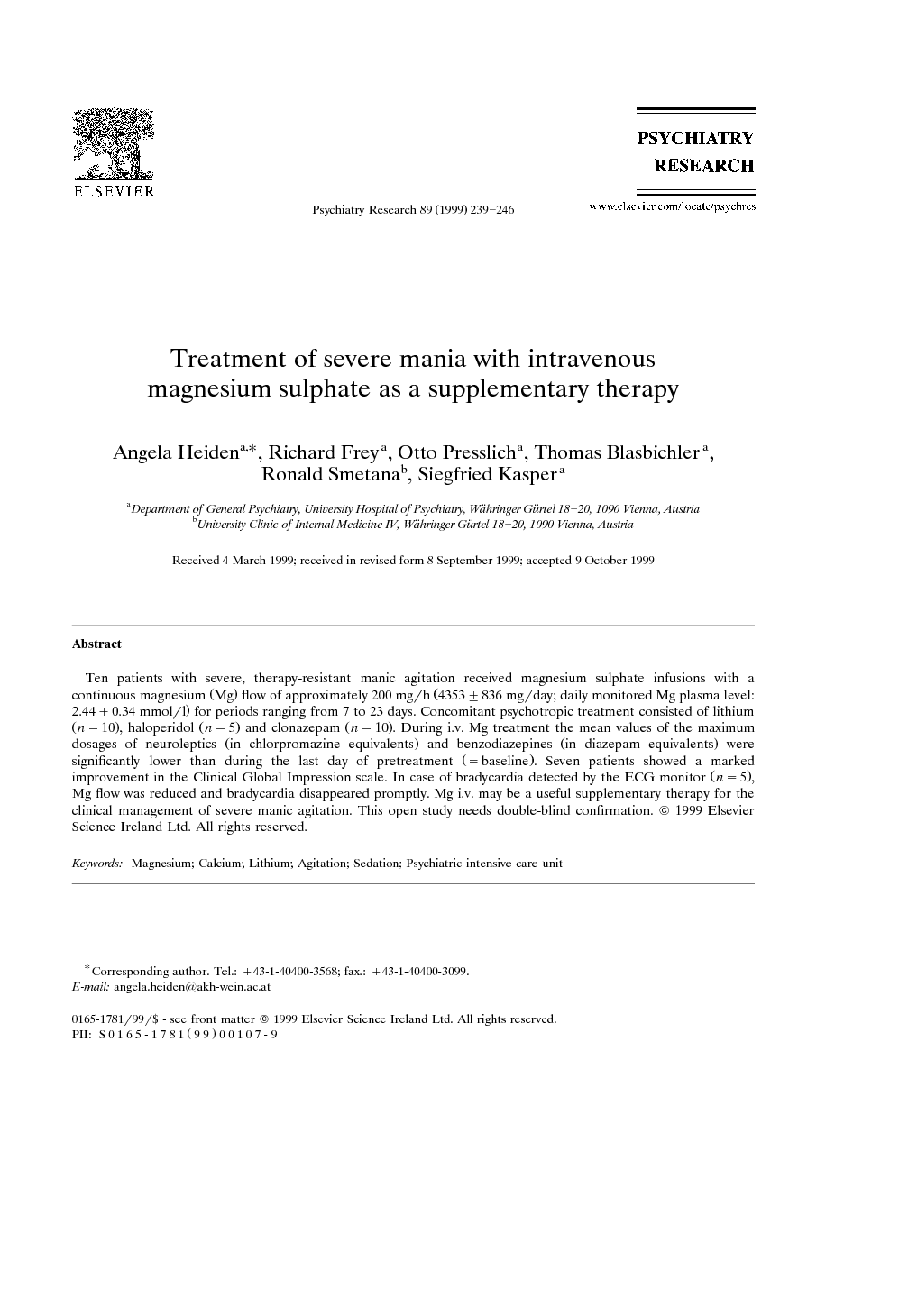Ten patients with severe, therapy-resistant manic agitation received magnesium sulphate infusions with a continuous magnesium (Mg) flow of approximately 200 mg/h (4353±836 mg/day; daily monitored Mg plasma level: 2.44±0.34 mmol/l) for periods ranging from 7 to 23 days. Concomitant psychotropic treatment consisted of lithium (n=10), haloperidol (n=5) and clonazepam (n=10). During i.v. Mg treatment the mean values of the maximum dosages of neuroleptics (in chlorpromazine equivalents) and benzodiazepines (in diazepam equivalents) were significantly lower than during the last day of pretreatment (=baseline). Seven patients showed a marked improvement in the Clinical Global Impression scale. In case of bradycardia detected by the ECG monitor (n=5), Mg flow was reduced and bradycardia disappeared promptly. Mg i.v. may be a useful supplementary therapy for the clinical management of severe manic agitation. This open study needs double-blind confirmation.
Gadget timed out while loading
Manic patients with severe agitation are often treated with high doses of various neuroleptics. Most conventional antipsychotics have extrapyramidal, anticholinergic (e.g. delirium, ischuria) and antiadrenergic (e.g. orthostatic hypotension) side effects. Sometimes changes in liver function occur. The use of high doses of various neuroleptics should be limited because they sometimes cause confusion and persistent excitement despite heavy sedation and respiratory dyskinesia that may lead to aspiration pneumonia (Kruk et al., 1995 and Casey, 1997).
We were trying to find a better tolerated treatment for patients with severe mania when our attention was drawn to the muscle-relaxing and sedative effects of intravenous (i.v.) magnesium (Mg) sulphate (Fodor et al., 1995). Hypermagnesemia is considered to act as a central nervous system depressant, and its sedative effects have proved to be useful in anesthesia (James, 1992 and Tramér et al., 1996). Furthermore, i.v. treatment with Mg salts has been found to be effective in disorders presenting with neuromuscular hyperexcitability such as pre-eclampsia and delirium tremens (Meignan, 1992, McLean, 1994 and Frakes and Richardson, 1997). Oral Mg aspartate was reported to be effective in the treatment of rapid cyclers (Chouinard et al., 1990).
Mg activates approximately 300 enzyme systems, including most of the enzymes involved in energy metabolism (Durlach, 1992a). Although the role of Mg in neuronal function is not completely understood, it has been shown that Mg can block calcium (Ca) influx and, in particular, non-competitively antagonize the N-methyl-d-aspartate (NMDA) channels ( Ascher and Nowak, 1987 and Lipton and Rosenberg, 1994). Intracellular Ca2+ ions play a fundamental role in the release of neurotransmitters and in the functioning of receptors involved in mood disorders ( Dubovsky et al., 1992). The mood stabilizers lithium and carbamazepine have Ca antagonistic properties ( Dubovsky and Franks, 1983 and Messing et al., 1985), and Ca channel blocking drugs like verapamil have been introduced as antimanic drugs ( Dubovsky, 1993). Magnesium, which has been called ‘nature's physiological Ca channel blocker’ ( Iseri and French, 1984), might also play a role in the treatment of manic excitement.
The recent interest in the sedative and muscle-relaxing effects of Mg prompted us to examine the efficacy and tolerability of Mg sulphate i.v. as a supplementary therapy in the clinical management of therapy-resistant manic agitation in a pilot study. We hypothesized that i.v. Mg would bring about a reduction in the dosages of antipsychotics and tranquilizers.


